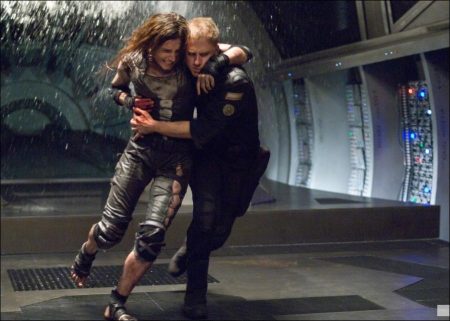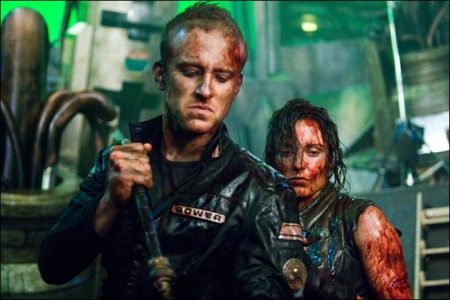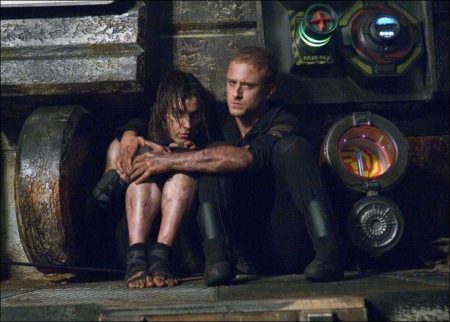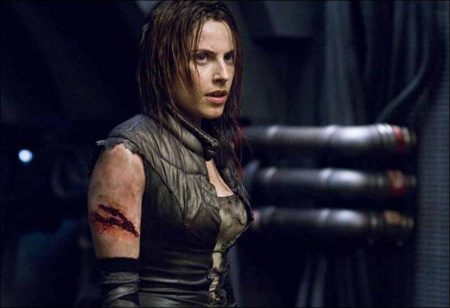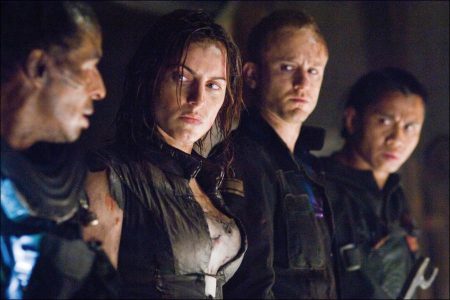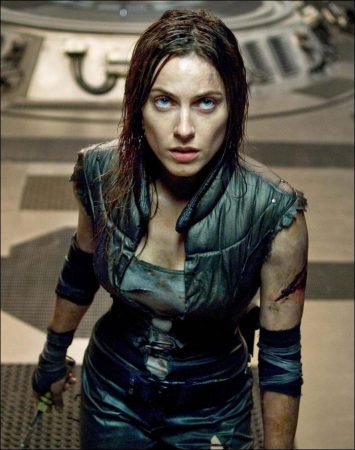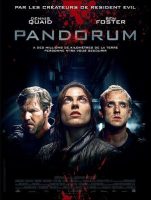Tagline: Fear what happens next.
Two astronauts awaken in a hyper-sleep chamber aboard a seemingly abandoned spacecraft. It’s pitch black, they are disoriented, and the only sound is a low rumble and creak from the belly of the spacecraft. They can’t remember anything – who are they, what is their mission?
The only way out of the chamber is a dark and narrow airshaft. Corporal Bower,, the younger of the two, crawls inside, while the other, Lt. Payton, stays behind for guidance on a radio transmitter. As Bower ventures deeper and deeper into the ship, he begins to uncover a terrifying reality. Slowly the spacecraft’s shocking and deadly secrets come unraveled, and the astronauts realize that the survival of mankind hinges on their actions.
Pandorum is a German-British 2009 science fiction horror film, with elements of Lovecraftian horror, and survival adventure. The film was directed by Christian Alvart and produced by Robert Kulzer, Jeremy Bolt and Paul W.S. Anderson. Travis Milloy wrote the screenplay from a story by Milloy and Alvart. It stars Dennis Quaid and Ben Foster. Filming began in Berlin in August 2008. Pandorum was released on 25 September 2009 in the United States,[3] and on 2 October 2009 in the UK.
The film’s title is a nickname of a fictional psychosis called “Orbital Dysfunctional Syndrome” (ODS for short) caused by deep space and triggered by emotional stress leading to severe paranoia, delirium, and nosebleeding. The film received mixed to negative reviews, but has gained a cult following over time.
Launching The Mission
Two years after working on the hugely successful Resident Evil franchise, the producing trio of Impact Pictures’ Paul W.S. Anderson and Jeremy Bolt and Constantin Film’s Robert Kulzer were ready to tackle their latest cinematic effort: the terrifying thriller Pandorum.
“I first read Pandorum right after finishing work on AVP,” says producer Anderson. “The script blew me away. I felt it visited places and touched on subjects I’d always been interested in, primarily the idea of horror on the edge of the universe – where terror is amplified by the claustrophobia of the ship and the isolation of deep space – the same reasons I made Event Horizon almost a decade earlier.” “I immediately passed the script on to Jeremy and Robert with the suggestion we should option it and mount the movie,” Anderson continues.
“I was always searching for a story that would make me say, `This could be IT,’” says producer Kulzer. “With Pandorum, I got really excited. To have an original movie is a fantastic thing.” Kulzer and his partners knew Pandorum was special.
The original screenplay for Pandorum was written by Travis Milloy. At around the same time he finished writing it, young German director Christian Alvart came to Hollywood after releasing his critically acclaimed cinematic debut, Antibodies.
Alvart began directing at the age of 16, shooting on super-8 with friends while first working for (and later owning) the special interest film magazine X-TRO. With his company, Syrreal Entertainment, he wrote, produced and directed Curiosity & the Cat in 1998, which was followed by the lauded psychological serial killer thriller Antibodies in 2005.
Upon arrival in Hollywood, Alvart himself was working on his own story called No Where, about four astronauts on a long distance space journey who awaken from hyper-sleep without any recollection of their mission’s purpose. “I didn’t think I’d be able to make that film within the next 15 years or so,” says Alvart, “as it was a project on a huge scale and hard to finance.”
After watching Antibodies – a dark and mysterious thriller full of twists and turns – and meeting Christian, producer Bolt thought of Alvart after reading the Pandorum script and sent it to him. “When I started reading,” says Alvart of Milloy’s script, “I was shocked because it shared many elements with my pet project. How could I make my movie if these guys already were making one just like it? “I pitched them my version of the story,” Alvart continues, “No Where merged with Pandorum. I expected to be laughed out of the room.” Instead, the producers got Milloy and Alvart together, and through a rigorous development process, Pandorum emerged. The filmmakers set out to transport the audience into the dark, mysterious depths of space with a scary, thrill-packed film full of smart and bizarre twists.
Uncharted Terrority
Filming began on August 11, 2008, in Studio Babelsberg, Potsdam, just outside Berlin. A number of international projects have shot at Babelsberg recently, and the film’s German production connections made it a perfect place for Pandorum to call home.
“We had such a good experience making the first Resident Evil film here,” says Bolt. “There are tremendously good crews here, and Berlin is a fantastic city. Who wouldn’t want to spend 5 months here?”
Director Alvart adds, “I shot Antibodies here, and I loved the crew and people. On a demanding project like Pandorum, I wanted to rely on people I knew.”
In addition, Berlin provided the physical conditions required for the shoot. “We wanted huge sets showing the Elysium’s and the mission’s dimension,” Kulzer says; they wanted a deepness to the locations that would create a vertigo effect. The location was important to the story as well, as the filmmakers wanted the audience to feel the vastness of the ship which in the film can hold up to 60,000 passengers. They found suitable places in the sound stages of Babelsberg and within an abandoned power plant in Berlin, Steglitz, where the last two weeks of shooting took place. “It looks like a spaceship already,” says Alvart. “We just had to add our sets.”
Overall, the production required 54 sets and locations. Production designer Richard Bridgland previously worked with the producers on Resident Evil, and was glad to come onboard for a whole new challenge. Together with Alvart, he created the film’s unique look – a sort of post-industrial futurism.
“This is a well-defined genre, and there’s a typical look to these movies,” says Bridgland. “But this script had a whole different feeling to it, a gothic element I really enjoyed.”
A film like Pandorum can offer huge creative freedom to a production team, but that freedom can make things even more difficult. Alvart says, “You have to solve a paradox every day: You want to believably portray a future nobody knows, yet you want to connect to the audience and make them relate to the characters and story.”
“It had to be very functional,” adds Bridgland. “Things had to work.” The intention – and ultimate result – was to create a look that differs from everything seen before, one that suited the dark and twisted Pandorum. “The sets themselves have to tell the story, so they gradually get more and more gothic and horrifying.”
Of working on set, Foster says, “We’re all affected by environment – emotionally and physically. The sets were designed to provoke a certain experience…and they were very effective in that department.”
Cam Gigandet says, “I expected a lot of green screen, which always makes me skeptical – you can usually see that it’s not real. With Pandorum, it was, `Oh my God, this could all happen.’”
“Digital effects always create a distance – even with today’s technique,” says Kulzer. “We felt the more sets we could actually build and the more realistic they looked, the better the actors could convey real emotions. And the more they get scared, the more the audience will get scared as well.”
The set, which became the actors’ home for three months, together with the fact that some of them had not been to Germany before and could not speak the language, evoked what they ultimately named the “Pandorum effect.” Actor Gigandet says, “The whole situation was quite surreal, and honestly, it brought out insecurity in me.” Foster, who shot each of the 52 production days, says, “The working pace we had, the sets, and the whole atmosphere of the movie certainly supported a feeling of confusion and anxiety.”
Traue adds, “Darkness was a big theme. It was dark when I’d get up, dark when I’d come home, and in between we’re shooting in all dark sets. After some weeks, it definitely had influence on me.” Producer Bolt laughs, “That was all deliberate – disorienting our actors is part of the method.”
The movie’s set design was supported by exceptional camera work and a strong lighting concept created by director of photography Wedigo von Schultzendorff. The film’s look is characterized by an intense interplay of blackness and bright colors like green, blue, yellow and red to emphasize particular situations. “It was definitely a challenge,” von Schultzendorff says. “The movie is set in deep darkness most of the time; I tried to design a more expressionistic distribution of light and create the illusion of darkness.”
Gerd Feuchter, SFX supervisor on Pandorum, says, “Our job was to make the light visible using steam, fog or dust, like a discotheque’s laser show.”
The film’s more exciting scenes are punctuated by spectacular effects work. As with the sets, efforts were made to keep things based in reality, and practical effects were used instead of digital effects whenever possible. Stunt coordinator Francois Doge says, “All the actors were very keen on practicing the stunts, and wanted to do as many as possible by themselves. This is quite rare, especially when the shoot is such a tough one. Honestly, they put heart and soul into this movie.” Ben Foster says, “I suppose it’s the daredevil thing. It’s just fun to jump off something or into something – that’s a boy’s dream.”
With such a complicated shoot, the producers and actors ultimately credit director Alvart and his crew with keeping everyone focused and on task. “The crew is really inspiring,” says Foster. “The rigor and care put into the film is amazing. And Christian is incredible. He had 1500 storyboards – 1500 pictures that he knows inside out! He’s certainly the most visually prepared and focussed director I’ve met.” Altogether about 500 people were engaged to bring the mass of storyboards to life.
The Evil
There’s a negative force that looms over the story and provides Pandorum with its terror, and that evil manifests itself in a variety of ways throughout the film, physically as well as psychologically. The force is evident even in the film’s apocalyptic pre-story, as mankind has destroyed Earth and needs a new place to live. Ben Foster relates to that premise: “The way we’re heading and the way we’re treating our environment is certainly frightening. Pandorum is just one potential fantasy of what could happen if we go on behaving the way we are.”
In the film, the word “pandorum” actually means Orbital Dysfunctional Syndrome, a sort of disease caused by the vastness, deep loneliness and isolation of space. “The dysfunction manifests itself in a kind of God-complex,” producer Bolt explains, “a disability to discern right from wrong, hallucinations, bleeding noses and trembling.”
The SFX costume and makeup departments created a very clear vision of how these psychological effects ultimately take their toll, becoming the story’s true evil: the Hunters. Originally humans meant to be resettled and establish a new civilization, they’ve mutated and proliferated into terrifying monsters during the 125 years the failed space journey has lasted.
Unlike zombies or aliens, the filmmakers wanted a more mysterious embodiment of evil for Pandorum’s creatures so audiences at first wouldn’t understand what they were. “The plan was to have kind of a shape-shifting creature,” says Kulzer. “The audience is trying to figure out what they are. Are they aliens? Are they supernatural? When they finally identify them, it’s `WOW.’”
To bolster the “wow effect” and increase the threat emanating from the Hunters, the filmmakers wanted them to be as real as possible and to again reduce CGI to a minimum. In a lengthy casting process, four actors were chosen to embody the four main Hunters: Heflin, Weasel, Hunter Shape and Hunter Brute. In total, 17 permanent Hunter actors were cast, and for four days of shooting in the Hunters’ hatchery approximately 70 extras were turned into mutants.
For creature makeup, the filmmakers turned to the famous Stan Winston Studio. With 30 years of experience on movies like Terminator, Aliens, Jurassic Park, and Iron Man, Stan Winston Studio ranks among the best special effects companies and creature designers in the world.
“The biggest challenge is to find something that hasn’t been done yet,” says Lindsay McGowan, SFX Chief Makeup. “But that’s the fun of it. You have to work the story and find the type of creature that fits.”
On the basis of storyboard scribbles by Alvart and first concept art by Stan Winston Studio, Ivana Milos designed the look of the Hunter garb, and Niels Müller transferred her drawings into actual costumes. The Hunters’ clothing/armor mainly consists of scrap metal taken from the ship, wrapped with leather straps and lined with skins to protect sensitive body parts and form mountings for their huge weapons…or trophies.
The looks were elaborate, and McGowan says, “We needed about three hours for the makeup process. Costume needed approximately two more.” The everyday makeup process included body painting; masks for the head, the hands and the feet; and fake teeth and lenses for the eyes. “It was a little torture for the guys, but they were all very patient and cooperative,” adds McGowan.
Particular attention with the makeup procedure was required to transform the child-age Hunter, played by a young girl named Luna – actually Alvart’s 8-year-old daughter. “Actually, I was looking at her brother to play the child Hunter,” Alvart says, “but she went along with him to the casting…and she won the role.” As the working hours of child actors are legally limited, makeup and costume had to find compromises to complete their work most efficiently within the time given. SFX makeup artist Arjen Tuiten, who’s worked on movies like Pan’s Labyrinth and Hellboy 2: The Golden Army, brought it down to just two hours. “Luna was lovely,” McGowan says. “She brought her computer and watched High School Musical. That kept her attention.”
Overall, the production is thrilled with the Hunters’ manifestation. “They’re not like creatures in a haunted house – monsters or mutants,” says Müller. “There’s an incredible concept about their movement, fighting, articulation and behavior, which is closely linked to the story; a whole philosophy that will engage the audience.”
The well-founded combination of physical and psychological elements created by the sets, costumes, props, stunts, and makeup runs like a red thread through Pandorum, working together to knit a dense net of tension, thrills, and horror for the audience. And if the filmmakers get their way, this won’t be the only time they’ll explore the world of the film. Director Alvart says, “Truth be told, this is only the first chapter in a trilogy of films I wish to make exploring the Pandorum universe.”
Pandorum (2009)
Directed by: Christian Alvart
Starring: Dennis Quaid, Antje Traue, Ben Foster, Cung Le, Norman Reedus, Cam Gigandet, André Hennicke, Wotan Wilke Möhring, Yangzom Brauen, Jeff Burrell, Niels-Bruno Schmidt
Screenplay by: Travis Milloy
Production Design by: Richard Bridgland
Cinematography by: Wedigo von Schultzendorff
Film Editing by: Philipp Stahl, Yvonne Valdez
Costume Design by: Ivana Milos
Art Direction by: Cornelia Ott, Ralf Schreck
Set Decoration by: Bernhard Henrich
Music by: Michl Britsch
MPAA Rating: R for strong horror violence and language.
Distributed by: Overture Films
Release Date: September 25, 2009
Visits: 94
